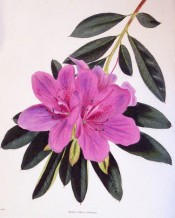Rhododendron pulchrum Sweet
A small to medium bush with rose-purple flowers with dark spots, 5-6cm across, borne in clusters of 1 to 4, introduced into England in 1824 and not known in the wild. [Hortus, Hilliers'].
Horticultural & Botanical History
Paxton's Magazine of Botany describes the flowers of A. indica phoenicea as brick red, which may be a reference to Rhododendron phoeniceum G.Don. [MB p.158/1840]. ‘A native of China, introduced in 1825 by the Horticultural Society, from whom we received it. It produces its magnificent flowers in May and June, and when planted in a conservatory, and grown to four or five feet high, is exceedingly ornamental. It may be increased by cuttings freely, and appears to like a shady situation, with great abundance of water.’ [LBC no.1735/1833].
History at Camden Park
Listed in all published catalogues [T.76/1843]. Azalea indica phoenicea is listed in both the 1830 and 1836 editions of Loddiges’ Nursery catalogue, copies of which are held at Camden Park [CPA].
Notes
Probably also synonymous with Azalea indica phoenicea Sweet.
In 1852 The Gardeners Chronicle commented: ‘The introduction of Azalea indica alba and phoenicea, together with the seedlings raised by the late Mr. Smith of Norbiton, tended still further to recommend the azalea to popular favour; and the appearance of A. variegata, lateritia, Gledstanesii and Danielsiona, completely established its merits’. [Gard. Chron. 1852].
The identity of Macarthur’s Azalea Indica phoenicea is uncertain. See also Rhododendron phoeniceum G.Don.
Published Jan 16, 2009 - 01:26 PM | Last updated Sep 30, 2011 - 05:00 PM
| Family | Ericaceae |
|---|---|
| Category | |
| Region of origin | Garden origin, China |
| Synonyms |
|
| Common Name | |
| Name in the Camden Park Record | Azalea Indica phoenicea
|
| Confidence level | medium |


